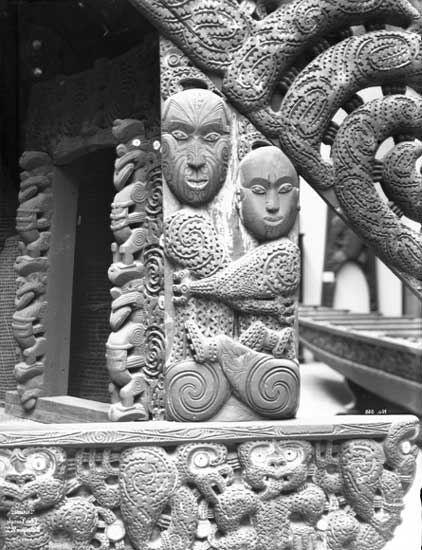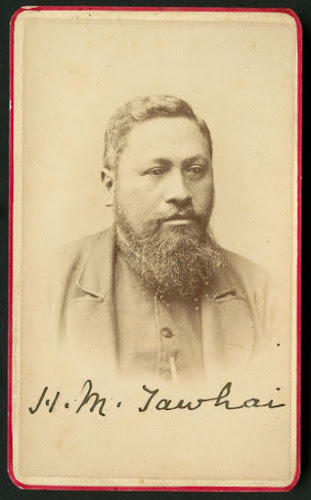Touring the Waikato War - A Photo Essay (Part Two)
In my previous post I discussed the first part of a recent journey around sites associated with the Waikato War, ending with Rangiriri. For the most part it is possible to track these sites from a northern to southern direction, with the first part of the war progressing from the Queen's Redoubt at Pokeno in July 1863, south to Rangiriri by November of that same year.
One site that does not quite fit this pattern is Pukekohe East Church, the scene of a significant engagement on 14 September 1863. It is some distance north of the Queen's Redoubt launching post for the invasion, indicating just how little progress the British made in the early part of the war.
A war party consisting of Ngāti Maniapoto and other iwi attacked local militia holed up in the church but came off badly, suffering as many as forty killed. In 1929 the government erected a memorial boulder to those who died.
Other memorial plaques, including one to those defending the church, were stolen in 2006.
After the Rangiriri conflict in November there seemed every prospect for peace. Governor George Grey demanded that British troops must be allowed to enter the Māori King's residence at Ngāruawāhia unimpeded before talks could take place. Early in December Cameron's men occupied the deserted settlement but Grey never came to talk peace.
Ngāruawāhia itself was strategically located at the junction of the Waikato and Waipā rivers, and its occupation allowed the British to push on further south.
By late January 1864, the British had advanced as far south as Pāterangi, where a formidable chain of defensive pā lay before them. After some weeks General Cameron concluded that a direct assault on these was too risky, instead deciding on a daring evening march around the defensive line. After setting off at around 11pm on the evening of 20 February 1864, the British forces reached the largely deserted settlement of Te Awamutu at about dawn the following morning. St John's Church, completed in the early 1850s, was the centre of John Morgan's mission station.
A number of Māori and British killed in nearby battles are buried in the adjacent cemetery, which includes a number of memorials to them.
A monument to Māori was initially commissioned by the government in the mistaken belief that those buried there were 'loyalists' or kūpapa. Although it was discovered in 1914 that they were actually Kīngitanga fighters killed in battle with the British, the government nevertheless went ahead with the memorial, which was unveiled in 1914.
Almost immediately after entering Te Awamutu, Cameron's men pushed on to Rangiaowhia, which was attacked early on a Sunday morning. The village was considered a place of refuge for women, children and the elderly. There were few defenders and a number of people were killed inside a whare that was probably deliberately torched by British troops, with one elderly man shot as he attempted to flee the burning hut. These events were remembered with great bitterness and pain many years later. Today, a Catholic cemetery and (some 200 metres up the road) St Paul's Anglican Church are all that remain of the original, flourishing settlement.
Upon hearing of the attack on Rangiaowhia, Kīngitanga men defending the Pāterangi line rushed back to aid their kin but were themselves attacked at the site of a partially constructed pā at Hairini on 22 February 1864, suffering further heavy losses.
On 23 February 1864 British troops entered and looted the deserted settlement of Kihikihi - the home of Rewi Maniapoto. In the early 1880s the government built a new cottage for Rewi in Kihikihi as an inducement for him to leave the King Country. Later a memorial to Rewi was constructed on the site, and he was buried there when he died in 1894.
Just five kilometres or so from Kihikihi, on Arapuni Road, is Ōrākau, site of what used to be called 'Rewi's Last Stand'. It was here that large numbers of Māori (as many as 160) were killed, most as they fled for their lives on the final day of the three-day siege.
It was said that the road was later run deliberately through the centre of the pā (although recent archaeological investigations by Heritage New Zealand have cast some doubt on its precise location).
In 1914 a crowd of nearly 5000 people, most of them Pākehā, gathered at Ōrākau for the unveiling of a memorial. They celebrated Ōrākau as marking 'fifty years of peace' and the birth of 'the greatest race relations in the world'.
Understandably, few Māori joined in their 'celebrations'. However, as Paul Diamond explains in this post, the sesquicentenary gathering in 2014 was of an altogether different nature.
One site that does not quite fit this pattern is Pukekohe East Church, the scene of a significant engagement on 14 September 1863. It is some distance north of the Queen's Redoubt launching post for the invasion, indicating just how little progress the British made in the early part of the war.
A war party consisting of Ngāti Maniapoto and other iwi attacked local militia holed up in the church but came off badly, suffering as many as forty killed. In 1929 the government erected a memorial boulder to those who died.
Other memorial plaques, including one to those defending the church, were stolen in 2006.
After the Rangiriri conflict in November there seemed every prospect for peace. Governor George Grey demanded that British troops must be allowed to enter the Māori King's residence at Ngāruawāhia unimpeded before talks could take place. Early in December Cameron's men occupied the deserted settlement but Grey never came to talk peace.
Ngāruawāhia itself was strategically located at the junction of the Waikato and Waipā rivers, and its occupation allowed the British to push on further south.
By late January 1864, the British had advanced as far south as Pāterangi, where a formidable chain of defensive pā lay before them. After some weeks General Cameron concluded that a direct assault on these was too risky, instead deciding on a daring evening march around the defensive line. After setting off at around 11pm on the evening of 20 February 1864, the British forces reached the largely deserted settlement of Te Awamutu at about dawn the following morning. St John's Church, completed in the early 1850s, was the centre of John Morgan's mission station.
A number of Māori and British killed in nearby battles are buried in the adjacent cemetery, which includes a number of memorials to them.
A monument to Māori was initially commissioned by the government in the mistaken belief that those buried there were 'loyalists' or kūpapa. Although it was discovered in 1914 that they were actually Kīngitanga fighters killed in battle with the British, the government nevertheless went ahead with the memorial, which was unveiled in 1914.
Almost immediately after entering Te Awamutu, Cameron's men pushed on to Rangiaowhia, which was attacked early on a Sunday morning. The village was considered a place of refuge for women, children and the elderly. There were few defenders and a number of people were killed inside a whare that was probably deliberately torched by British troops, with one elderly man shot as he attempted to flee the burning hut. These events were remembered with great bitterness and pain many years later. Today, a Catholic cemetery and (some 200 metres up the road) St Paul's Anglican Church are all that remain of the original, flourishing settlement.
Upon hearing of the attack on Rangiaowhia, Kīngitanga men defending the Pāterangi line rushed back to aid their kin but were themselves attacked at the site of a partially constructed pā at Hairini on 22 February 1864, suffering further heavy losses.
On 23 February 1864 British troops entered and looted the deserted settlement of Kihikihi - the home of Rewi Maniapoto. In the early 1880s the government built a new cottage for Rewi in Kihikihi as an inducement for him to leave the King Country. Later a memorial to Rewi was constructed on the site, and he was buried there when he died in 1894.
Just five kilometres or so from Kihikihi, on Arapuni Road, is Ōrākau, site of what used to be called 'Rewi's Last Stand'. It was here that large numbers of Māori (as many as 160) were killed, most as they fled for their lives on the final day of the three-day siege.
It was said that the road was later run deliberately through the centre of the pā (although recent archaeological investigations by Heritage New Zealand have cast some doubt on its precise location).
In 1914 a crowd of nearly 5000 people, most of them Pākehā, gathered at Ōrākau for the unveiling of a memorial. They celebrated Ōrākau as marking 'fifty years of peace' and the birth of 'the greatest race relations in the world'.
Understandably, few Māori joined in their 'celebrations'. However, as Paul Diamond explains in this post, the sesquicentenary gathering in 2014 was of an altogether different nature.
















Comments
Post a Comment